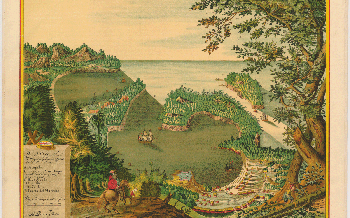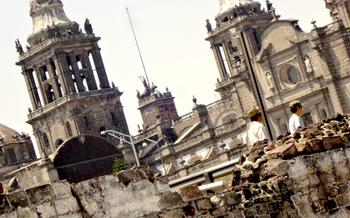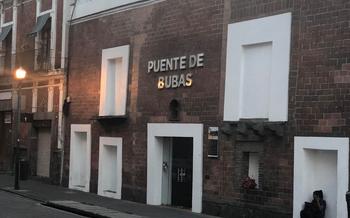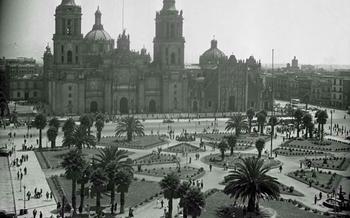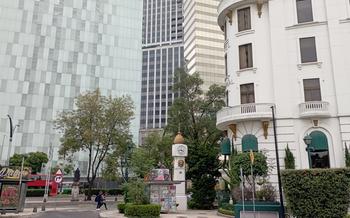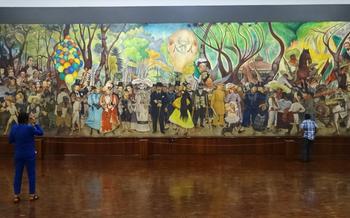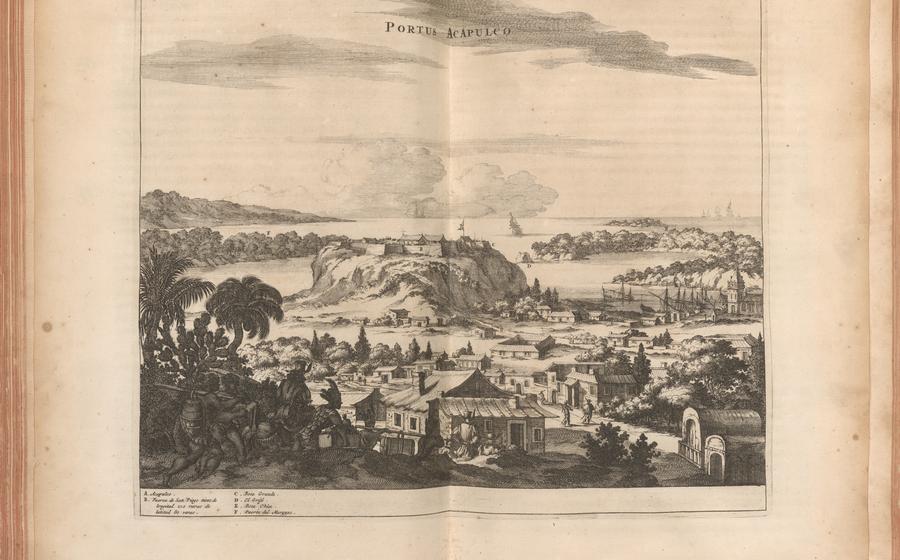
Acapulco Historical Archive Museum
- Location and Accessibility
- Hours of Operation and Admission Fees
- Guided Tours and Language Support
- Exhibits and Displays
- Historical Context of Acapulco
- Independence and Revolution
- Gold and Silver Trade
- Cultural Significance
- Interactive Exhibits and Educational Programs:
- Research and Archival Resources:
- Temporary Exhibitions and Events
- Museum Shop and Souvenirs:
- Accessibility for Visitors with Disabilities:
- Insider Tip:
Location and Accessibility
The Acapulco Historical Archive Museum is conveniently located in the heart of the city, at [Insert Museum's Address]. It is situated near several landmarks, including the Acapulco Cathedral, the Zócalo, and the Acapulco Bay. Reaching the museum is a breeze, whether you choose to explore the city on foot, utilize public transportation, or drive your own vehicle.
For those who prefer public transportation, numerous bus routes stop within walking distance of the museum. Additionally, taxis and ride-sharing services are readily available in Acapulco, making it easy to get to the museum from anywhere in the city.
For those arriving by car, there are several parking options nearby. The museum offers a limited number of parking spaces on-site, subject to availability. Alternatively, you can find street parking in the surrounding area or utilize one of the nearby public parking lots.
To help you navigate your way, we have included a map below with directions to the Acapulco Historical Archive Museum. Simply click on the map to access the interactive version and get turn-by-turn directions from your current location.
Hours of Operation and Admission Fees
The Acapulco Historical Archive Museum welcomes visitors from Tuesday to Sunday, providing ample opportunities to explore its fascinating exhibits. Its operating hours are from 9:00 AM to 5:00 PM, allowing you to conveniently plan your visit. It's important to note that the museum may have special hours or closures on certain holidays, so it's advisable to check their website or social media pages for the most up-to-date information.
Admission fees are quite reasonable, making it accessible to visitors of all budgets. The general admission fee is $75 Mexican pesos, while students, seniors, and groups of 10 or more people can enjoy a discounted rate of $50 Mexican pesos. Additionally, the museum offers free admission on Sundays, encouraging locals and tourists alike to immerse themselves in Acapulco's rich history.
Guided Tours and Language Support
The Acapulco Historical Archive Museum offers guided tours in multiple languages to enhance the visitor experience. These tours provide deeper insights into the exhibits and allow visitors to ask questions and engage with knowledgeable guides. Guided tours can be booked in advance to ensure availability, especially during peak tourist season. Additionally, the museum offers audio guides in various languages for self-guided exploration, allowing visitors to learn at their own pace. With these language support services, the museum ensures that visitors from different linguistic backgrounds can fully appreciate Acapulco's rich history and cultural heritage.
Exhibits and Displays
The Acapulco Historical Archive Museum showcases a diverse range of exhibits and displays that provide a comprehensive overview of the city's rich history and cultural heritage. From pre-Columbian artifacts to colonial-era documents, from the gold and silver trade to the Mexican Revolution, the museum's collection offers a tangible connection to Acapulco's past.
Notable exhibits include a replica of the Manila Galleon, which transported precious cargo between Acapulco and the Philippines, and a collection of rare maps and charts that illustrate Acapulco's strategic importance as a port city. Visitors can also explore interactive displays that bring history to life, such as a virtual tour of the city's colonial fortifications or a simulation of the gold and silver trade route.
The museum's exhibits are organized chronologically and thematically, allowing visitors to trace Acapulco's development from its humble beginnings to its rise as a major international port. Multimedia presentations, touch screens, and interactive games enhance the visitor experience and make learning about Acapulco's past both enjoyable and educational.
Historical Context of Acapulco
Acapulco's history is as rich and diverse as its culture. The city's pre-Columbian roots can be traced back to the Olmec and Mayan civilizations, who left behind artifacts and ruins that speak to their advanced societies. In the 16th century, Acapulco became a major port for the Spanish Empire, serving as a gateway for trade between Asia and Europe. The Manila Galleon trade route brought immense wealth and cultural exchange to the city, transforming it into a vibrant cosmopolitan hub.
Over the centuries, Acapulco faced numerous challenges, including pirate attacks, natural disasters, and political upheavals. However, the city's strategic location and resilient spirit ensured its survival and growth. In the 19th century, Acapulco became a popular tourist destination for its beautiful beaches and tropical climate. The city's allure attracted Hollywood celebrities and jet-setters, who flocked to Acapulco for its glamorous nightlife and luxurious resorts.
Acapulco's rich history is interwoven with the stories of its people, from indigenous communities to Spanish conquistadors, pirates, and modern-day tourists. The city's historical landmarks, including the Acapulco Historical Archive Museum, serve as a testament to its enduring legacy and cultural significance.
Independence and Revolution
During the tumultuous periods of Mexico's struggle for independence and the Mexican Revolution, Acapulco played a significant role. The Acapulco Historical Archive Museum houses a rich collection of documents and artifacts that shed light on these transformative eras. Visitors can explore manuscripts, letters, and proclamations that narrate the stories of local heroes and leaders who fought for freedom and justice. The museum also features exhibits on the impact of these historical events on Acapulco's society and culture, showcasing how the city's people navigated the challenges and changes brought about by war and revolution. This chapter of Acapulco's history is a testament to the resilience and determination of its people, and the museum provides a valuable glimpse into this fascinating period.
Gold and Silver Trade
In its heyday, Acapulco served as a pivotal port for the global gold and silver trade. The Manila Galleon trade route, established in the 16th century, linked Acapulco with Manila in the Philippines, creating a lucrative exchange of goods and precious metals. Spanish galleons laden with silver from Mexico's mines would sail across the Pacific to Manila, where they were exchanged for Chinese silks, spices, and other exotic goods. These treasures were then transported back to Acapulco, where they were distributed throughout the Americas and Europe. The museum houses a fascinating collection of artifacts related to the galleon trade, including maps, ship models, and trade goods, shedding light on this crucial chapter in Acapulco's history. Visitors can learn about the economic and cultural impact of this trade route, as well as the challenges and dangers faced by the galleon crews who braved the vast oceans.
Cultural Significance
Acapulco's rich cultural heritage is showcased in the Acapulco Historical Archive Museum. The museum houses a collection of traditional crafts, musical instruments, and costumes that provide a glimpse into the city's vibrant cultural traditions. Visitors can learn about the influence of indigenous, Spanish, and African cultures on Acapulco's cuisine, music, and dance forms. The museum also highlights the contributions of famous artists, writers, and musicians who have roots in Acapulco. These include the renowned Mexican muralist Diego Rivera, who captured the essence of Acapulco's culture and landscapes in his artwork. By showcasing Acapulco's cultural heritage, the museum helps visitors gain a deeper understanding of the city's unique identity and its place in Mexican history.
Interactive Exhibits and Educational Programs:
The Acapulco Historical Archive Museum engages visitors with a range of interactive exhibits and educational programs that bring history to life. Through hands-on activities, workshops, and lectures, the museum fosters a deeper understanding of Acapulco's rich past. Interactive displays allow visitors to explore historical documents, maps, and artifacts, while multimedia presentations provide a vivid glimpse into the city's transformation over the centuries. The museum also offers guided tours that delve into specific themes or periods of Acapulco's history, providing visitors with expert insights and a personalized experience. These interactive elements not only enhance the visitor experience but also promote cultural education and awareness, making the Acapulco Historical Archive Museum a valuable resource for learning and exploration.
Research and Archival Resources:
The Acapulco Historical Archive Museum serves as a vital research and archival center for scholars and historians seeking to delve into the city's rich past. Its extensive collection of historical documents, photographs, and maps provides invaluable insights into Acapulco's development over the centuries. Researchers can access these resources to conduct in-depth studies on various aspects of Acapulco's history, from its pre-Columbian origins to its role in the gold and silver trade and its involvement in Mexico's struggle for independence and the Mexican Revolution. The museum's collection also includes rare artifacts and special collections that attract scholars from around the world. Whether you are a student, a researcher, or simply someone with a passion for history, the Acapulco Historical Archive Museum offers a wealth of resources to explore and learn about the city's fascinating past.
Temporary Exhibitions and Events
The Acapulco Historical Archive Museum is not just a repository of the past; it is also a vibrant cultural hub that hosts a variety of temporary exhibitions, special events, and festivals throughout the year. These events offer visitors a chance to experience Acapulco's rich history and culture in new and engaging ways.
Temporary exhibitions often focus on specific aspects of Acapulco's past, such as its role in the gold and silver trade, its colonial heritage, or its modern-day cultural scene. These exhibitions showcase rare artifacts, documents, and photographs that provide a deeper understanding of Acapulco's unique history.
In addition to exhibitions, the museum also hosts a variety of special events, such as lectures, workshops, and performances. These events bring together historians, artists, musicians, and other experts to share their knowledge and insights on Acapulco's past and present. Visitors can learn about traditional crafts, listen to live music, or participate in hands-on workshops that allow them to experience Acapulco's culture firsthand.
To stay up-to-date on the latest exhibitions and events, visitors are encouraged to check the museum's website or social media pages. These platforms also provide information on upcoming events and workshops, as well as special promotions and discounts.
Museum Shop and Souvenirs:
The Acapulco Historical Archive Museum boasts a well-stocked museum shop where visitors can purchase a variety of souvenirs, books, and merchandise related to Acapulco's rich history and vibrant culture. From postcards and magnets featuring iconic landmarks to replicas of ancient artifacts, the museum shop offers a unique selection of items that are perfect for commemorating your visit and sharing with friends and family.
Proceeds from the museum shop directly support the museum's mission to preserve and showcase Acapulco's cultural heritage. By purchasing souvenirs, visitors not only take home a piece of Acapulco's history but also contribute to the museum's ongoing efforts to protect and promote the city's unique identity.
The museum shop offers a wide range of souvenirs to suit every budget and taste. Visitors can choose from intricately crafted silver jewelry inspired by pre-Columbian designs to hand-woven textiles featuring traditional Mexican patterns. There is also a selection of books on Acapulco's history, culture, and architecture, as well as children's books that bring Acapulco's past to life for young learners.
Whether you're looking for a unique gift or a special memento of your time in Acapulco, the museum shop at the Acapulco Historical Archive Museum is sure to have something for you.
Accessibility for Visitors with Disabilities:
The Acapulco Historical Archive Museum is committed to providing an inclusive and accessible experience for all visitors, including those with disabilities. The museum features ramps and elevators to ensure that all levels of the museum are wheelchair accessible. Additionally, there are designated parking spaces for visitors with disabilities located near the museum entrance. For visitors with hearing or visual impairments, the museum offers assistive listening devices and large-print materials upon request. The museum staff is also trained to provide assistance and accommodations to visitors with disabilities. To ensure a smooth and enjoyable visit, visitors with disabilities are encouraged to contact the museum in advance to discuss any specific needs or requests.
Insider Tip:
For a truly immersive experience, time your visit to coincide with one of the museum's special events or temporary exhibitions. These events often feature live music, dance performances, or historical reenactments that bring Acapulco's past to life. Check the museum's website or social media pages for upcoming events and plan your visit accordingly. Additionally, if you're interested in delving deeper into Acapulco's history, consider booking a guided tour in Spanish or English. The knowledgeable guides will provide fascinating insights into the exhibits and share stories that will leave a lasting impression.
